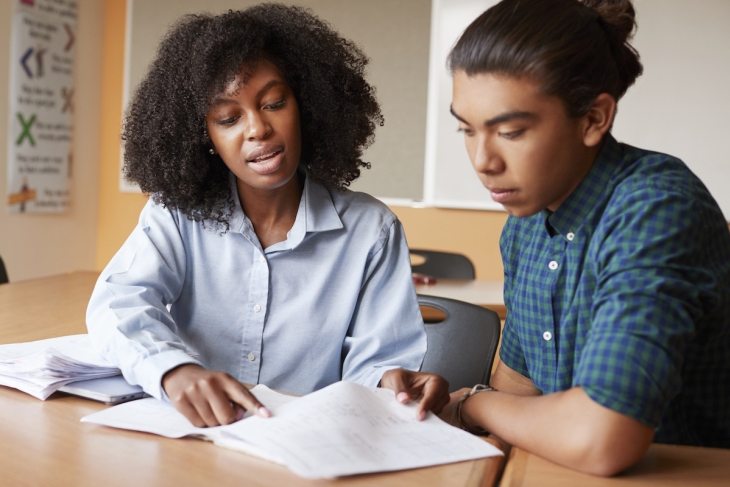Since 2022, public schools in the District of Columbia have been working to mitigate Covid learning disruptions by establishing and ramping up high-impact tutoring (HIT) efforts. Data on the outcome of these efforts are beginning to emerge, and a new report from the National Student Support Accelerator (NSSA) shows some minimally encouraging signs.
NSSA is an offshoot of the Stanford Accelerator for Learning and Systems Change for Advancing Learning and Equity, an initiative focused on researching how tutoring can best benefit students. Its new report looks at the first full year of HIT implementation in D.C. schools during 2022–23. Tutoring efforts that year concentrated on math and English language arts (ELA) for students in all grades and was focused on schools—both district and charter—with the greatest concentrations of students identified as at risk. It’s interesting to note that “at risk” doesn’t generally mean academic risk for schools in the district, but rather centers primarily on student socioeconomic status and homelessness, in the context of this wholly-academic intervention. Pre-existing academic need appears not to have been a driving force in choosing where tutors were placed, although some data suggest that academic performance may have influenced teachers’ decisions on which students to refer for tutoring.
A total of 5,135 students in 151 schools received HIT. Eligible buildings were those in which 40 percent or more of their students were categorized as at risk. Approximately 52 percent receiving HIT were district (DCPS) students, with charter school students making up the remainder. Overall, 6 percent of all D.C. public school students—and just 8 percent of all students categorized as at risk—received HIT. Of these students, 3,240 received tutoring in ELA and 2,558 in math. Tutoring hours received were highest in grades K–2, falling off starting in grade three. High school freshmen and seniors received the fewest hours of tutoring. Students, on average, participated in twenty-seven individual sessions. Seventy percent of students participated in eleven or more tutoring sessions. The report includes some details on the widely varying types of tutoring offered.
For students in grades K–8, achievement in math was measured by iReady assessments taken at the beginning, middle, and end of the year. These findings reflect DCPS students only; no data for charter school students were able to be calculated. Tutoring students began the school year 0.19 standard deviations below their non-tutored peers and ended the school year 0.14 standard deviations below. While tutored students still scored below their non-tutored classmates, the gap between the two groups did diminish, and students who received more tutoring shrunk the gap the most. Students who participated in more than twenty tutoring sessions were able to shrink their gap with non-tutored peers from 0.23 standard deviations to 0.14 standard deviations. The same pattern was observed in an analysis of Reading Inventory Scores for tutored and non-tutored students. This analysis covered a fuller cohort, including grades 2–12, but again did not include charter students. Outcomes for students in grades 7–12 were measured by the MAP math assessment, and students who received the most tutoring (twenty or more sessions) managed to outscore their non-tutored peers by the final test of the year. A tiny bright spot.
In terms of achievement, data from the annual PARCC assessment, administered in the spring of 2023, were available for all D.C. students, including charter students, for grades 3–11. However, the researchers conclude only that the findings—tutored students fared worse across the board than non-tutored peers and that those who received the most tutoring actually performed the worst of all groups—suggest that teachers likely chose their lowest-performing students to receive tutoring even though that was not a stated criterion for selection.
Non-academic outcomes discussed in the report include school attendance (students with better school attendance participated in more tutoring sessions, on average, and vice versa), student perceptions of tutoring, and tutoring program managers’ impressions of the program.
While these findings are generally positive, they are also rather modest, given the scope of the problem at hand. If the rates of gap closing don’t increase from the snail’s pace observed here, it will take years of additional work for tutored students to meet the test score performance of their non-tutored peers. Older students don’t have years to wait, and two cohorts of students have already graduated since the start of this HIT effort. We also know from this report that tutoring participation declines sharply in higher grades. Additionally, funding for tutoring in D.C. and elsewhere initially came from federal pandemic-relief funds, which are now exhausted and not sure to continue. All signs point to a diminishing effect going forward from the endpoint of these data, which should temper even the most enthusiastic responses to these findings.
SOURCE: Cynthia Pollard et al., “Implementation of the OSSE High Impact Tutoring Initiative: First Year Report School Year 2022–2023,” National Student Support Accelerator (August 2024).




